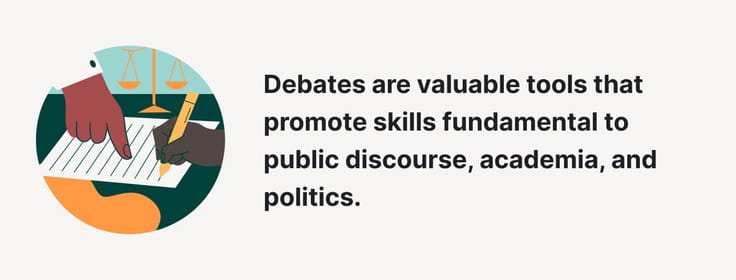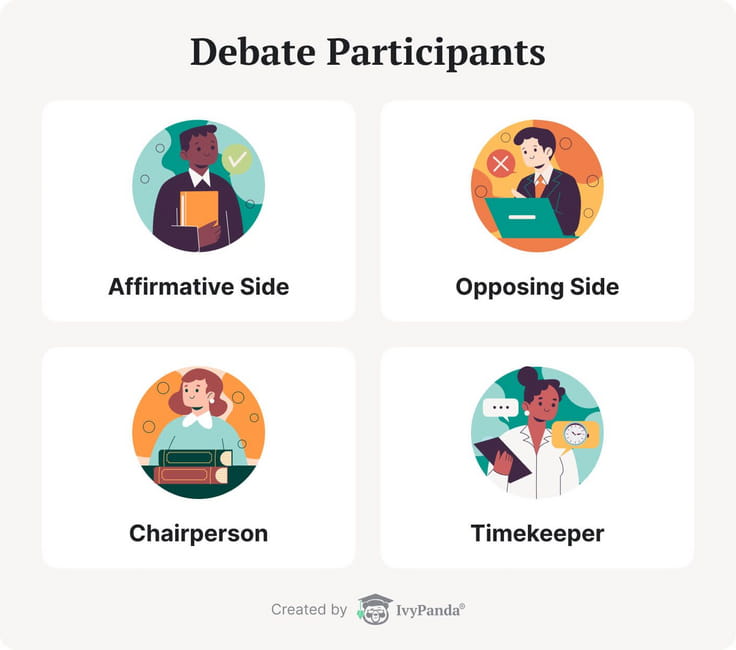Instant Debate Speech Maker Online
Debates are an excellent opportunity to develop many personal skills, become a more open-minded person, and learn new information. Through this activity, students improve critical thinking, public speaking, teamwork skills, increase their self-esteem, and learn to disagree with others.
Preparing for a debate can take a lot of time, which is why our team has created this tool and guide for you. With our debate speech maker, you no longer have to sit for hours and think about how to formulate your argument correctly! Also, on this page you will learn many useful facts about debates and get tips for preparing for them.
📢 Debate Script Maker: An Introduction
If you’ve decided to participate in a debate, you probably know that this activity requires a lot of preparation. Sometimes, you may receive the topic of your debate in advance so that you have time to prepare thoroughly for it. But also, you may be given the subject on the day of the debate, and then you’ll have much less time to prepare. In either case, our debate maker will be an indispensable assistant!

When comparing AI vs human writers, artificial intelligence excels in the speed of content creation, although it loses in creativity. Unlike when using other AI chat bots, you don't have to bother with creating successful prompts. Using this tool is simple - to instantly make a speech, you’ll need to take these four steps:
- Type in the topic of the debate.
- State your position and audience.
- Indicate whether you are replying to an opponent.
- Click “Generate” and get your result!
🗣️ What Is a Debate?
A debate is a structured and formalized argumentative exchange between two or more opposing sides. While this practice is usually associated with the election season, it can also be often found in schools or colleges. Participants, categorized as either the “pro” or “con” side, systematically present and defend their perspectives on a given topic. They use evidence to back up their claims and. Each side takes turns articulating arguments and responding to their opponent's points.
The primary objective of a debate is persuasion - convincing the opposition and the audience. Although debates often lack a declared winner, they may conclude with a vote or judgment from adjudicators in formal settings. Informal debates can persist until one side concedes.
Debate Terminology Examples for Students
Here, you can become familiar with the basic terms. It’ll be beneficial for you to learn them to make it easier to grasp the debate structure further.
- Adjudicator - An impartial observer who evaluates the debate. Such moderators provide feedback on the quality of arguments and overall performance. Also, they can contribute to determining the winner in formal debates.
- An affirmative - A team or speaker supporting the motion in a debate. Affirmatives present arguments in favor of the proposition. They aim to convince the audience or adjudicators of the motion's validity.
- Motion - The central topic, idea, or statement being debated. The motion frames the discussion and determines the stances of the affirmative and opposition sides. Debaters construct arguments either in support or against this subject.
- Chairperson - The person responsible for moderating and overseeing the debate. Their goal is to maintain order and ensure adherence to the rules. The chairperson may introduce speakers and the motion.
- Card - A card is a paragraph or several paragraphs taken from an authoritative journalistic or scholarly source that proves the validity of a particular argument. It should be a verbatim quotation without additions or paraphrasing. It is important to explain the quote and how it relates to the argument.
- Floor - The general audience or participants who are not actively engaged in the debate but may have the opportunity to pose questions. They can make contributions during designated segments. The floor adds an interactive element to the discussion.
- Opposition/a Negative - A team or speaker taking an opposing stance on the core topic. The opposition presents arguments countering the proposition. Such arguments should demonstrate flaws in the affirmative's position and persuade the audience that the motion is unsupported.
- The first speaker - The initial speaker of a team. They introduce and establish the main arguments supporting or opposing the motion. Their speech should set the tone for the team's position and outline the critical points to be developed by subsequent speakers.
- The second speaker - The second speaker introduces additional evidence and reinforces the team's position. They aim to strengthen their affirmative/opposing case and respond to the arguments from the other team.
- The third speaker - The last speaker should summarize the team's key points. They may also respond to opposition’s reasons raised during the debate. The goal is to leave a lasting impression on the adjudicators before the discussion concludes.
- Reply speeches - Reply speeches are the concluding words from both the affirmative and opposition sides. These speeches are often shorter, not more than three minutes. Such speeches are the last chance to influence the overall impression, so they should strongly support your ideas.
What Does the Maker of the Argument Do in a Debate?
In a debate, the first speaker, whether on the affirmative or opposition side, should:
- Formulate a clear and concise stance on the motion.
- Organize arguments logically, presenting a structured case.
- Support points with relevant facts and examples.
- Convince adjudicators and the audience of the credibility of their position.
The Structure of a Debate
Whether an academic debate or a parliamentary one, the structure and ground rules essentially remain the same.

In this section, we'll briefly explain how your proceedings are going to look like:
- Gathering the sides.
At this stage, you should determine the teams and their participants. They are divided into affirmative and negative sides. As a rule, the debates should include three speakers, who will take turns and, at each stage, strengthen their position. All participants should meet 15 minutes before the start to prepare materials. - Starting the debate.
Participants should determine the debate’s time limit, as speeches cannot last nonstop. Usually, each speaker is given a maximum of 3 minutes for their presentation. At the beginning, the speakers should introduce themselves. The duration of the answer is regulated by the timekeeper, who should give a bell 30 seconds before the end of the speaker's time to start summarizing. - Debating the topic.
The core of the debate involves a structured exchange between the sides. The first speaker for the affirmative introduces the motion, presenting key arguments. The opposition's first speaker responds, presenting counterarguments. This pattern continues with subsequent speakers building upon and responding to the points raised. The debate format could also include cross-examination or questioning segments. - Finishing the debate.
Both sides deliver final counter-speeches summarizing key arguments. The adjudicators then assess the overall performance of each side. The persuasiveness of the arguments presented assists in the audience’s decision-making. Participants may engage in discussions and receive feedback. After the debate, each team is given the opportunity to thank everyone in attendance.
👍 Debate Maker Benefits
As you've probably already realized, getting ready for such a significant event will take a lot of time. You'll need to gather your thoughts, stay level-headed, and be assertive in your stance. This preparation process can be quite overwhelming. That's why our debate script maker is the perfect solution!
This debate writer has many advantages:
✏️ How to Write a Debate Speech
Our tool is a great way to save time and get that initial burst of inspiration for your debate. However, that is just the beginning. You will still need to edit and finalize this speech. Additionally, you may find it helpful to learn how to write one yourself.

The following steps will show you how to improve your speech and prepare you for your future debates:
- Compelling beginning.
The opening of your speech is of the utmost significance. Your task is to captivate the audience and create the overall atmosphere of the speech. We suggest using a hook at the very beginning. It can be a question or a fact intended to capture the attention of your opposition and the audience. You could also use a quote from a famous person, an interesting statistic, a rhetorical question, or even a relevant personal anecdote. - Presenting your arguments.
This is the time to talk about your position on the topic. Be sure to formulate a concise thesis statement. After that, you should provide the arguments that support it. Explain each point clearly to avoid misunderstanding among the audience. - Explaining the position.
Follow a structure where each of your arguments is followed by evidence and then justification. Proof builds credibility and engages the listeners. Ensure that you have data only from relevant and reliable sources. - Summarizing.
In the concluding part of your persuasive speech, you should reiterate your thesis and essential arguments. Emphasize the value of your position. It’s your last opportunity to impress the judge and the listeners. Round it off by offering a provocative question, a recommendation, or talking about your predictions for the future of the subject. - Confidence and consistency.
After writing your speech, you should refine its structure so that you have smooth transitions from one idea to the next. Use connecting words to tie your arguments together. Afterward, practice your speech and make sure it's clear. Your gestures, facial expressions, and intonation are ways to communicate with listeners. Be convincing but not pushy, and use a moderate pace.
We wish you good luck in your debates! And if you need to create a different kind of speech, try our informative speech generator.
Updated:
🔗 References
- What is a debate? – Vanesa Velkova, European Commission
- How debating works – Law Society of Scotland
- Debating: A Brief Introduction for Beginners – Debating SA Incorporated
- Debate Timing & Structure - Debating Matters
- How do you structure your debate speech to capture the attention and interest of your audience? - LinkedIn